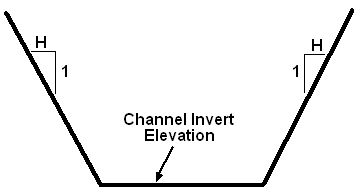HY8:Channel Shape: Difference between revisions
No edit summary |
No edit summary |
||
| Line 7: | Line 7: | ||
Channel Slope — Slope of channel in m/m or ft/ft. If a zero slope is entered, an error message appears upon exiting the input data window. The user must enter a slope greater than zero before the crossing may be analyzed. | Channel Slope — Slope of channel in m/m or ft/ft. If a zero slope is entered, an error message appears upon exiting the input data window. The user must enter a slope greater than zero before the crossing may be analyzed. | ||
Manning's 'n' — User defined MANNING'S roughness coefficient for the channel. | Manning's ''n'' — User defined MANNING'S roughness coefficient for the channel. | ||
Channel Invert Elevation — User must enter elevation. Program will show actual barrel #1 outlet invert elevation | Channel Invert Elevation — User must enter elevation. Program will show actual barrel #1 outlet invert elevation | ||
Revision as of 15:57, 29 April 2013
There are three available channel shapes to define the downstream tailwater channel: rectangular, trapezoidal, and triangular. When selecting a channel shape the input window adjusts to display only those parameters required for the defined shape. When defining a channel shape, the following channel properties are required for analysis:
Bottom Width — Width of channel at downstream section, shown in drawing below.
Side Slope (H:V) (_:1) — This item applies only for trapezoidal and triangular channels. The user defines the ratio of Horizontal/Vertical by entering the number of horizontal units for one unit of vertical change.
Channel Slope — Slope of channel in m/m or ft/ft. If a zero slope is entered, an error message appears upon exiting the input data window. The user must enter a slope greater than zero before the crossing may be analyzed.
Manning's n — User defined MANNING'S roughness coefficient for the channel.
Channel Invert Elevation — User must enter elevation. Program will show actual barrel #1 outlet invert elevation

